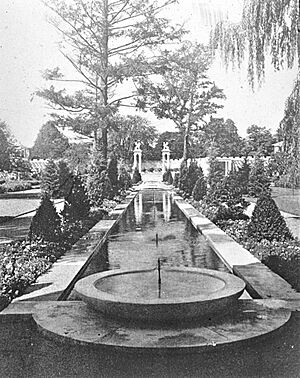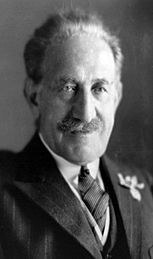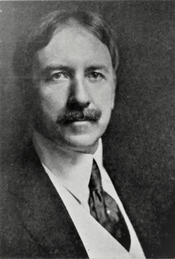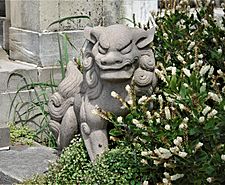Untermyer Park and Gardens facts for kids
Quick facts for kids |
|
|
Untermyer Park and Gardens
|
|
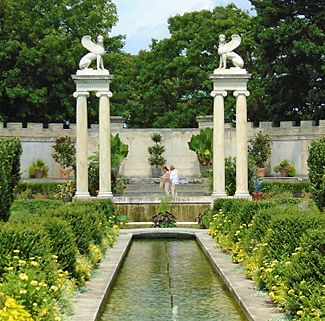
Sphynxes in the amphitheater of the Walled Garden
(2020) |
|
| Location | 945 North Broadway Yonkers, New York |
|---|---|
| Area | 43 acres (17 ha) |
| Built | c.1916-1940 |
| Architect | William W. Bosworth |
| Architectural style | various |
| NRHP reference No. | 74002263 |
| Added to NRHP | May 31, 1974 |
Untermyer Park and Gardens is a beautiful 43-acre public park. It is located in Yonkers, New York, just north of New York City. This park is a part of what was once a much larger 150-acre estate called "Greystone."
The park sits on a steep hillside that goes down to the Hudson River. It has many amazing features. You can find a special Walled Garden inspired by ancient Persian gardens. There is also a small Greek-style outdoor amphitheater with two sphinx statues. Other cool spots include a classical pavilion, a stoa, and loggias. Don't miss the "Temple of Love," which is a unique rock and water area. There is also a long staircase from the Walled Garden to an Overlook with great views of the river and the Palisades.
The gardens were created starting in 1916 by Samuel J. Untermyer. He was a very important lawyer and community leader. The main designer was architect William W. Bosworth. Other artists helped too, like Paul Manship who made sculptures. These gardens were often open to the public. Famous dancers, actors, and musicians even performed there. They were known as some of the best gardens in the United States.
When Samuel Untermyer passed away in 1940, he wanted to give the whole estate to the government. Eventually, the City of Yonkers agreed to take a part of it. This section, which included the main gardens, was named Untermyer Park and Gardens. It was added to the National Register of Historic Places in 1974. Today, the gardens are being carefully restored to their former glory.
Contents
History of Untermyer Gardens
The story of Untermyer Gardens began in 1865. A man named John T. Waring bought 33 acres of land. He built a large mansion with towers on it. He called his new home "Greystone." This name is still used for the nearby train station.
In 1879, Samuel J. Tilden rented the mansion. He was a former governor of New York. He soon bought the estate. Tilden loved plants and built 13 greenhouses. He grew many beautiful plants, fruits, and vegetables.
Tilden died in 1886. In 1899, Samuel J. Untermyer bought the property. It was 133 acres at that time. Untermyer was a very successful lawyer. He was known for being the first lawyer in the U.S. to earn a million dollars for one case. He became very rich. He also started working on cases that helped the public.
Creating the Gardens
Untermyer had a huge passion for growing plants. He said he learned this from his mother. He was an expert gardener himself. He wanted his estate to have amazing formal gardens. He even wanted them to be better than those of John D. Rockefeller! Rockefeller's estate, Kykuit, was not far away.
So, in 1916, Untermyer bought more land. This made his estate 150 acres. He then hired William Welles Bosworth. Bosworth was a talented architect and landscape designer. Untermyer told him to build "the finest garden in the world."
The land at Untermyer's estate was not flat. It was rocky and uneven. It sloped steeply down to the Hudson River. Bosworth had to work with this challenging landscape. Untermyer also wanted many different plants, fruits, and flowers.
Bosworth came up with a plan for the gardens. There would be six main parts. These included the Walled Garden, the Vista, and the Temple of Love. The Walled Garden was the most important part. It was about 3 acres in size. Bosworth called it an "Indo-Persian kind of garden." It had tall walls with towers on three sides. The walls were covered in a cream-colored plaster with a diamond pattern. The fourth side was open to views of the Hudson River.
The Walled Garden had canals running through it. One canal went from the entrance to the amphitheater. Another canal crossed it, with a small pool in the middle. Untermyer hired an engineer, Charles Wellford Leavitt, to design the fountains. Sadly, the fountains are not working today.
The Walled Garden also had the Temple of the Sky. This was an open-air circular building. It had 14 tall columns and overlooked a swimming pool. The floor had a beautiful mosaic with a Medusa head in the center.
For a time, these gardens were among the most famous in the U.S. Untermyer opened them to the public every week in the 1920s and 1930s. People came to see his amazing chrysanthemums and tulips. In 1939, 30,000 people visited in just one day! Famous artists like Isadora Duncan also performed there. The gardens were known for their excellent plant care. Many great gardeners learned their skills there. The estate eventually had 60 greenhouses and 60 gardeners.
The Gardens After Untermyer
Samuel Untermyer died in 1940. He wanted to give the gardens to the U.S. government or New York State. But keeping up the gardens was very expensive. There was no money set aside for their care. So, at first, no one wanted them.
Finally, in 1946, the City of Yonkers accepted 16 acres of the land. It became a public park. The mansion itself was later taken down. Because there wasn't enough money, much of the park fell into disrepair. Some buildings crumbled, and parts became overgrown.
In the 1990s, community leaders worked to save the gardens. With help from the Trust for Public Land, Yonkers bought more of the original estate. This created the 43-acre park we see today. Untermyer Park and Gardens was added to the National Register of Historic Places in 1974.
Since 2011, a group called the Untermyer Gardens Conservancy has been working to restore the gardens. They work with the Yonkers Parks Department. They have received grants to help with the work. The Conservancy now employs a head gardener and six other full-time gardeners. They are bringing the gardens back to life!
Exploring the Gardens
Untermyer Park and Gardens has many main features. Some have been saved, some restored, and some reimagined. There are also parts of original features, like the Sundial Garden and the Rose and Dahlia Garden.
The Walled Garden
The Walled Garden is surrounded by walls with towers. It is based on ancient Indo-Persian gardens. These were called Paradise gardens. Like those old gardens, it is divided into four sections by waterways. This idea comes from the four gardens of Paradise mentioned in the Qur'an and the Bible.
The four waterways in Untermyer Gardens meet in a pool at the center. Even though the idea is Indo-Persian, many parts of the Walled Garden are Greek-inspired. For example, the Temple of the Sky is a circular building with columns. It overlooks a large swimming pool with lion's heads spouting water. There is also a stoa on the eastern wall for guests to relax.
The open-air amphitheater is at the north end. Performers would entertain guests there. A special part of the amphitheater is the two marble sphinx statues. They were sculpted by Paul Manship, a famous artist. These sphinxes sit on platforms supported by tall columns.
Other parts of the garden, like the main entrance gate, have designs from ancient Mycenaean culture. The gate looks like the Great Lion Gate of Mycenae, but without the lions. The floor of the amphitheater stage has patterns from an ancient city called Tiryns. These patterns include spirals and lotus blossoms.
The Vista and Overlook
The Vista is a long staircase that goes down from the Walled Garden. It leads towards the Hudson River. At the bottom, it ends at the Overlook. This staircase was inspired by the Renaissance era Villa d'Este in Italy. The sides of the staircase were originally planted with trees.
The Overlook has two large ancient Roman marble columns. These columns once belonged to the famous architect Stanford White.
Lion & Unicorn Gate and Ruin Garden
The Lion and Unicorn Gate is an entrance to the gardens. It is located at the Old Croton Aqueduct State Historic Park. The old gatehouse is now the Ruin Garden, finished in 2019. The lion and unicorn sculptures were fixed up, and the unicorn even got a new head!
A root cellar was turned into a grotto with a fountain. Real graffiti inside the gatehouse was kept. The plants in this garden are meant to make it feel like an old, abandoned house.
Rhododendron Walk
The Rhododendron Walk is a new part of the gardens, added in 2019. It has many rhododendron plants. It reminds visitors of Samuel Untermyer's own collection of these flowers. This walk leads from the Ruin Garden to the main gardens above.
The Temple of Love and Rock and Stream Garden
The Temple of Love is a unique rocky area. It was designed by a stone mason named Carlo Davite. It has a round temple building on top. In Untermyer's time, it was surrounded by a large rock garden. Many of the rocks are hollowed out to hold plants.
The Rock and Stream Garden is what's left of the original Rock Garden. It used to have a small stream running through rocks. It was hidden for many years. Now, it has been rebuilt using original parts. It connects to the water flow of the Temple of Love, which has waterfalls, ponds, and bridges.
Gallery
-
One of Paul Manship's sphynxes
-
The Overlook, with the Hudson River Palisades in the background




